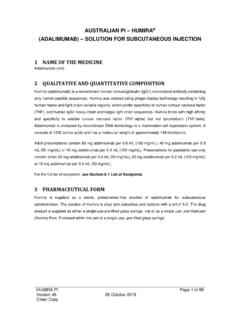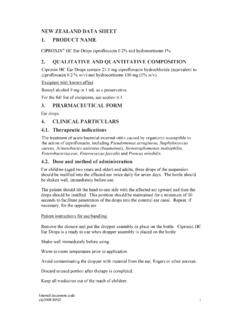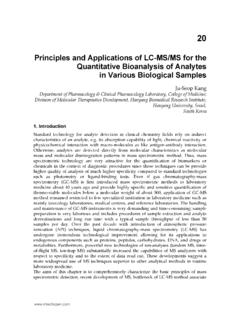Transcription of 2. QUALITATIVE AND QUANTITATIVE COMPOSITION
1 1 NEW ZEALAND DATA SHEET 1. PRODUCT NAME SUBOXONE 2 mg sublingual tablet SUBOXONE 8 mg/2 mg sublingual tablet 2. QUALITATIVE AND QUANTITATIVE COMPOSITION Each sublingual tablet of SUBOXONE 2 mg contains 2 mg buprenorphine (as hydrochloride) and mg naloxone (as hydrochloride dihydrate). Each sublingual tablet of SUBOXONE 8 mg/2mg contains 8 mg buprenorphine (as hydrochloride) and 2 mg naloxone (as hydrochloride dihydrate). Excipients with known effect: The sublingual tablets contain lactose (as monohydrate): 42 mg in each SUBOXONE 2 mg and 168 mg in each SUBOXONE 8 mg/2 mg. For the full list of excipients, see section 3.
2 PHARMACEUTICAL FORM Sublingual tablet SUBOXONE 2 mg: white, hexagonal, biconvex tablets debossed with a N2 . SUBOXONE 8 mg/2 mg: white, hexagonal, biconvex tablets debossed with a N8 . 4. CLINICAL PARTICULARS Therapeutic indications Treatment of opioid dependence, within a framework of medical, social and psychological treatment. Naloxone is included in SUBOXONE to deter intravenous misuse of the product. Dose and method of administration Treatment with SUBOXONE sublingual tablets is intended for adults and children aged 16 years or over who have agreed to be treated for opioid dependence. When initiating SUBOXONE treatment, the physician should be aware of the partial agonist profile of the molecule to the opioid receptors, which can precipitate withdrawal in opioid-dependent patients if given too soon after the administration of heroin, methadone or another opioid.
3 To avoid precipitating withdrawal, induction with buprenorphine should be undertaken when objective and clear signs of withdrawal are evident. The route of administration of SUBOXONE is sublingual. The sublingual formulation is not designed to be split or broken. SUBOXONE tablets should not be swallowed as this reduces the bioavailability of the medicine. Physicians must advise patients that the sublingual route is the only effective and safe route of administration for this medicine. Please note: The following instructions refer to the buprenorphine content of each dose. 2 Method of Administration Suboxone tablets are to be placed under the tongue until dissolved, which usually requires 2 to 10 minutes.
4 Patients should not swallow or consume food or drink until the tablet is completely dissolved. The dose is made up from 2 mg and 8 mg sublingual tablets, which may be taken all at the same time or in two divided portions; the second portion to be taken directly after the first portion has dissolved. Starting SUBOXONE An adequate maintenance dose, titrated to clinical effectiveness, should be achieved as rapidly as possible to prevent undue opioid withdrawal symptoms due to inadequate dosage. Prior to induction, consideration should be given to the type of opioid dependence ( , long- or short-acting opioid), the Patients taking Heroin (or Other Short-acting Opioids): When treatment starts the dose of SUBOXONE should be taken at least 6 hours after the patient last used opioids and when objective signs of withdrawal appear.
5 A score of 12 on the validated Clinical Opioid Withdrawal Scale (COWS) may be a useful reference assessment. The recommended starting dose is 4-8 mg SUBOXONE on Day One, with a possible additional 4 mg depending on the individual patient s requirement. The suggested target total dose for Day One is in the range of 8-12 mg SUBOXONE. Patients on Methadone: Before starting treatment with SUBOXONE, the maintenance dose of methadone should be reduced to the minimum methadone daily dose that the patient can tolerate. The first dose of SUBOXONE should be taken at least 24 hours after the patient last used methadone. The initial 4-8 mg SUBOXONE induction dose should ideally be administered when objective signs of withdrawal are evident ( COWS score > 12).
6 The suggested target total dose for Day One is in the range of 8-12 mg SUBOXONE. During the initiation of treatment, closer dosing supervision is recommended to ensure proper sublingual placement of the dose and to observe patient response to treatment as a guide to effective dose titration according to clinical effect. Dosage Adjustment and Maintenance The dose of SUBOXONE should be increased progressively according to the clinical effect in the individual patient. The dosage is adjusted in increments or decrements of 2 8 mg buprenorphine to a level that maintains the patient in treatment and suppresses opioid withdrawal effects according to reassessments of the clinical and psychological status of the patient.
7 In clinical studies many patients were stabilised on a daily maintenance dose of 12 mg/3 mg to 16 mg/4 mg of SUBOXONE, although some patients may require higher doses. A maximum daily dose of 32 mg should not be exceeded. During maintenance therapy, it may be necessary to periodically restabilise patients to new maintenance doses in response to changing patient needs. Dose adjustment in hepatic impairment Use of SUBOXONE is contraindicated in patients were severe hepatic impairment. SUBOXONE may not be appropriate for patients with moderate hepatic impairment. SUBOXONE may be used with caution for maintenance treatment in patients with moderate hepatic impairment, who have initiated treatment on a buprenorphine-only product.
8 Patients with moderate hepatic impairment prescribed SUBOXONE should be monitored for signs and symptoms of precipitated opioid withdrawal. In addition, lower initial doses and cautious titration of dosage may be required in patients with moderate hepatic impairment. No dosage adjustment is needed in patients with mild hepatic impairment. Less than Daily Dosing of SUBOXONE After a satisfactory period of stabilisation has been achieved the frequency of dosing may be decreased to dosing every other day at twice the individually titrated daily dose. For example, a patient 3 stabilised to receive a daily dose of 8 mg may be given 16 mg on alternate days, with no medication on the intervening days.
9 However, the dose given on any one day should not exceed 32 mg. In some patients, after a satisfactory period of stabilisation has been achieved, the frequency of dosing may be decreased to 3 times a week (for example on Monday, Wednesday and Friday). The dose on Monday and Wednesday should be twice the individually titrated daily dose, and the dose on Friday should be three times the individually titrated daily dose, with no medication on the intervening days. However, the dose given on any one day should not exceed 32 mg. The patient should be observed following the first multi-dose administration to initiate the less-than daily dosing regimen and whenever treated with high doses.
10 Patients who sporadically use concomitant CNS-active medications or substances should be monitored closely. Reducing Dosage and Stopping Treatment The decision to discontinue therapy with SUBOXONE should be made as part of a comprehensive treatment plan. A gradual dose taper over a period of 21 days is shown in Table 1. Table 1. Gradual dose taper schedule Week 20 mg Maintenance dose 16 mg Maintenance dose 8 mg Maintenance dose 1 16 mg 12 mg 8 mg 2 8 mg 8 mg 4 mg 3 4 mg 4 mg 4 mg Contraindications Hypersensitivity to buprenorphine or naloxone or any other component of the tablet. Children less than 16 years of age. Severe respiratory or hepatic insufficiency.














